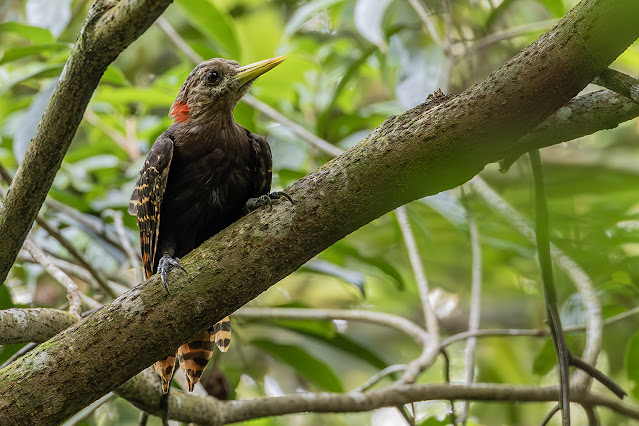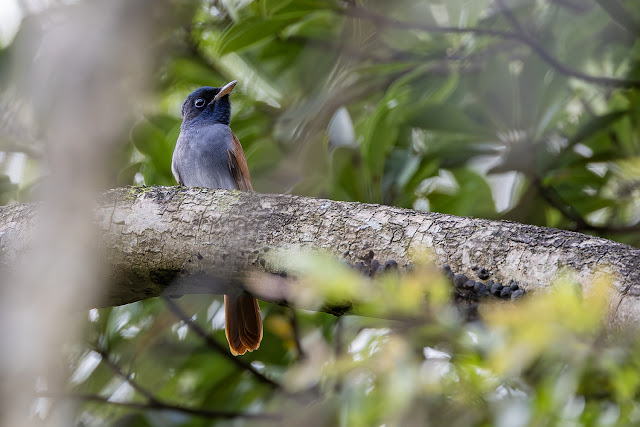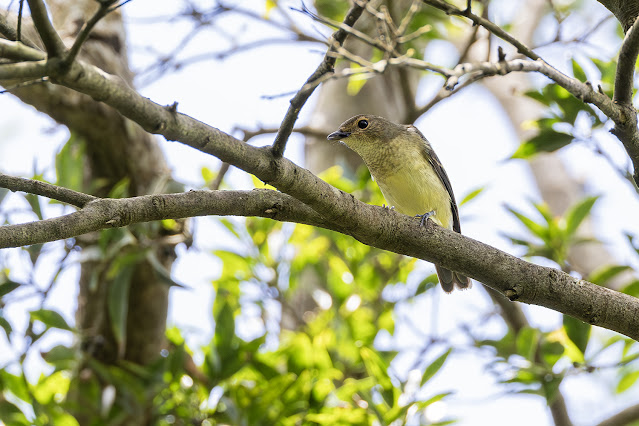I swear if anyone tells me global warming doesn't exist I will be most tempted to throw them off a cliff. Mid-autumn festival just passed by, and we just had our hottest one ever since record began. You would expect the temperature to be dropping slightly now that it is officially autumn, but unfortunately it is still very hot during the day, with temperature exceeding 34°C on some days! That being said, more autumn migrants are coming through, even some winter visitors are now returning. Amur Stonechat is one of those winter visitors that always arrives quite early, Green Sandpipers as well are now returning. Red Collared Dove is also a migrant or winter visitor in Hong Kong, some are now returning to the fish ponds, this lovely looking male seen at San Tin.
 |
| Amur Stonechat - female |
 |
| Green Sandpiper |
 |
| Red Collared Dove - male |
I haven't been out birding much myself other than when I am working, but there are signs of migrants around, such as various Arctic Warblers out and about, and a very pretty male Black-naped Oriole which only decided to show up briefly.
 |
| Arctic Warbler |
 |
| Black-naped Oriole - male |
Whiskered Terns are now arriving in their hundreds at the fish ponds, although they are a common species I always enjoy seeing these marsh terns around. Here are some shots of them in the rain.
 |
| Whiskered Tern |
Tai Po Kau's been slightly disappointing on my last visit, with no visible migrants around, I am sure there were some there I just didn't chance upon them. I did however got very lucky with an extremely bold male Bay Woodpecker, which stayed there for 10 minutes in full view! I have never experienced that in Hong Kong, and likely not going to have another like this for a long while. A single Speckled Piculet showed briefly, but never came close. Also present was a Lesser Shortwing which showed well, by the looks of it I am guessing its a female without the white eyebrows.
 |
| Bay Woodpecker - male |
 |
| Speckled Piculet |
 |
| Lesser Shortwing - female |
Scarlet-backed Flowerpecker and Fork-tailed Sunbirds are both tiny but colourful birds, at this time of the year they are not always easy to photograph, as there aren't many flowering trees, or fruiting mistletoes (at least not low down), luckily got two chances to photograph both species with guests, first a Scarlet-backed Flowerpecker that came down low, and a Fork-tailed Sunbird taking a bath on a small hole filled with water on a tree branch.
 |
| Scarlet-backed Flowerpecker - male |
 |
| Fork-tailed Sunbird - male |
I have mentioned many times that the Streak-breasted Scimitar-Babbler is my favourite babbler species in Hong Kong, I just think they have so much character. While a common species, they are never easy to photograph well, so when opportunity arrises, I rarely say no.
 |
| Streak-breasted Scimiter-Babbler |
I have been out herping a few times this month, there were plenty of instances I did not take any photographs (a Checkered Keelback, Mountain Water Snake, Anderson's Stream Snake...), here are a few that I did. The ever so fabulous looking Marbled Pygmy Frog, the Fujian Large-headed Frog, a Bamboo Pit-Viper posing nicely, and the ever so impressive looking Reeve's Tokay Gecko, with the door of an abandoned house.
 |
| Marbled Pygmy Frog |
 |
| Fujian Large-headed Frog |
 |
| Bamboo Pit Viper |
 |
| Reeve's Tokay Gecko |
And a few good butterflies, the Rounded Palm-redeye, locally more commonly known as the 'Banana Skipper', which is a banana specialist as their caterpillars feeds on banana leaves. The Fluffy Tit, with far more frequent records in recent years, I would not really consider it as a hugely rare butterfly anymore. And, the Malayan, another formerly very rare species, is now recorded regularly in recent years, but this was still a first sighting for me.
 |
| Rounded Palm-redeye |
 |
| Fluffy Tit |
 |
| Malayan |
Hopefully, we will get some cooler weather next week...















































